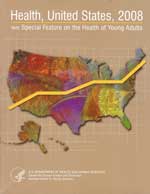Health, United States, 2008 with Special Feature on the Health of Young Adults

NTIS Order Number: PB2009-106184
Link to the full text report on the CDC Website.
Health, United States, 2008, is the 32nd annual report on the health status of the Nation prepared by the Secretary of the Department of Health and Human Services for the President and Congress. In a chartbook and 151 detailed tables, it provides an annual picture of the health of the entire Nation. Trends are presented on health status and health care utilization, resources, and expenditures. This year's report includes a special feature on young adults, age 18 to 29 years. As young people in this age group reach legal adulthood, they make many life choices, including decisions about education, marriage, childbearing, and health behaviors such as tobacco and alcohol use, which will affect both their future economic and health status as well as affect the well-being of their families.
For those entrusted with safeguarding the Nation's health, monitoring the health of the American people is an essential step in making sound health policy and setting research and program priorities. Health measures provide essential information for assessing how the Nation's resources should be directed to improve the population's health. Examination of emerging trends identifies diseases, conditions, and risk factors that warrant study and intervention. Health, United States presents trends and current information on measures and determinants of the Nation's health. It also identifies variation in health, health behaviors, and health care among people by race and ethnicity, gender, education and income level, and geographic location. Given the increasing diversity of the Nation and the continuing changes in the health care infrastructure, this is a challenging and critically important task.
Major topics covered in the 600-page report include:
Health Care Resources
Health care technologies, facilities, equipment, and provider specialties have changed
over recent decades. Until the mid-20th century, general hospitals and primary care
physicians were the major providers of health care. There are now more specialized
health care facilities, including imaging centers, outpatient surgical centers,
and dialysis centers, as well as physician specialties and subspecialties.
Expenditures and Health Insurance
The United States spends more on health per capita than any other country, and health
spending continues to increase.
Use of and Access to Health Care Services
Americans consume vast amounts of health care services, as indicated by the large
amount they spend on personal health care services.
Disparities in Health and Health Care by Income and Racial and Ethnic Group
Health, United States, 2008, identifies major disparities in health and
health care by socioeconomic status, race, ethnicity, and insurance status. Many
aspects of the health of the Nation have improved, but the health of some income,
and racial and ethnic groups has improved less than others and for some groups,
the gap has widened.
Special Feature: Young Adults Age 18-29 Years
The period starting with age 18 and spanning the 20s is often considered the transition
to adulthood, when young people obtain legal and emotional independence, invest
in education, begin working to obtain financial independence, and choose to marry
or to have children. This transition is also the period when financial and other
support services previously provided by parents, social and government programs,
and school health and education programs are decreased or terminated, often abruptly.